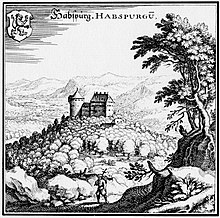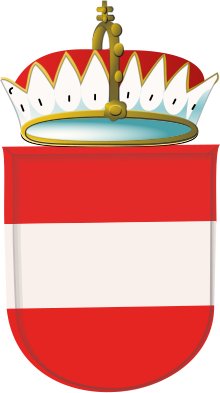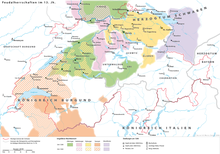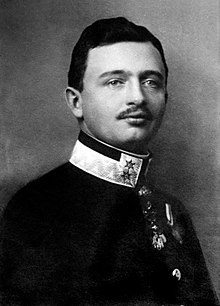Habsburg

The Habsburg (also House of Habsburg , House Austria and Casa de Austria ) are on their ancestral castle in what is now the Swiss canton of Aargau named princely family, which in Europe since the late Middle Ages in addition to - the - and in competition with Capetians rise for half a millennium, the most powerful dynasty and also ruled a colonial empire over the kingdoms of Spain and Portugal .
The name “House of Austria” was transferred from the country, the Duchy of Austria to the Habsburgs in the 14th century . This designation was then carried over to the lands ruled by the Habsburgs. With the upgrading of the Austrian duchy to an archduchy , the ruling family was also designated as an ore house . It was the only dynasty in the world to use the title Archduke ( created by itself ) .
The Habsburgs initially had large land holdings in Upper Alsace between Basel and Strasbourg . In October 1273, Rudolf I was the first Habsburg to be elected King of the Holy Roman Empire . Five years later he was able to defeat his rival Ottokar von Böhmen , who had stood against him in the election of the king, in the battle of Marchfeld (August 26, 1278) east of Vienna . After the victorious battle in which Ottokar fell, Rudolf asked I. occupied by Ottokar duchies Austria , Styria and Krain under his rule and managed it first themselves. By Ottokar original dominions of Bohemia and Moravia with his son Wenceslas II. Decided to leave and this married to one of his daughters, he strengthened the power of the Habsburgs.
In 1283, Rudolf I gave the duchies of Austria and Styria as a fief to his sons Albrecht I and Rudolf II and thus brought about the rise of his house from counts to princes . By mutual agreement, Albrecht I administered Austria and Styria alone, while Rudolf II withdrew to the old family property in Aargau and Upper Alsace.
After the last Meinhardiner Henry of Carinthia had died on 2 May 1335, transferred Emperor Ludwig of Bavaria the dukes of Austria , Albrecht II. And his brother, Otto the Merry , the duchies of Carinthia and Krain as a fiefdom . In 1363, Duke Rudolf IV also succeeded in bringing Tyrol to the Habsburgs.
From 1438 and 1526/1527, Bohemia , Croatia and parts of Hungary came under the rule of the Habsburgs. With the Bohemian crown, the electoral dignity and thus one of seven votes in the college that elected the Roman-German king finally fell to the Habsburgs in 1526 . From 1439 to 1806 the House of Habsburg provided the German kings and Roman-German emperors almost continuously .
In the 16th century, the dynasty was divided into a Spanish line, which ruled over Spain and Portugal and their overseas possessions in America , Africa and Asia and whose male line died out with Charles II in 1700 , and an Austrian line, whose male line became Charles VI in 1740 . ended, but was continued through his Pragmatic Sanction , which he tried to secure with his neighbors, namely the descendants of his eldest daughter Maria Theresa (but the regulation did not apply to the head of the Holy Roman Empire, who had to be a man). Maria Theresa founded the House of Habsburg-Lothringen through her connection with Franz I Stephan from the House of Lothringen, who as Franz I achieved the dignity of Emperor in the empire . The Roman-German imperial dignity remained in this house until the end of the empire in 1806. The last Roman-German emperor, Franz II , founded the Austrian Empire in 1804 as Franz I of Austria , which was converted into the Austro-Hungarian dual monarchy in 1867/68 and existed until 1918. After 1918 the Habsburgs had to renounce their claims to power in both Austria and Hungary .
At times the Habsburgs also ruled over other European areas, including the Habsburg Netherlands and the Free County of Burgundy , in Upper Italy over Milan as well as parts of Lombardy and the countries in Upper Germany that were formerly known as Front Austria . Secondogenitures (subsidiary lines) ruled Tuscany , Modena and Parma from the 18th century and in Mexico for a short time in the 19th century .
The head of the family has been Karl Habsburg-Lothringen as the eldest son of Otto von Habsburg , the last Crown Prince of Austria-Hungary , since 2007 .
Habsburg as the House of Austria (Casa de Austria)
House of Austria ( Latin domus Austriae , Spanish Casa de Austria , French Maison d'Autriche , Italian Casa d'Austria ) is a name for both the Habsburg power (the territories of the Habsburg monarchy , especially the hereditary lands ) and the entire noble family in Austria and the Spanish line and its subsidiary lines.
The name Haus Österreich derives from the Latin expression domus Austriae . It can be traced for the first time in 1326 and from the first half of the 15th century it became a common term in German as well. With the establishment of the Austrian Empire in 1804, the term lost its meaning.
Habsburg Monarchy (also Habsburg Empire ) was the unofficial name for theentire domains of the Habsburg dynasty ruledin personal union in the modern era until 1918 in Europe (usually excluding the lands of the Spanish Habsburgs), i.e. its hereditary lands , which were hereditary to the house, and the respective elected offices.
history
Early Habsburgs after the Acta Murensia (until 1279)

The early generations of the Habsburgs can be reconstructed on the one hand on the basis of genealogical records that were made as early as 1160, and on the other hand on the basis of the will of Werner I (1030-1096). The will is dated to 1027, but was probably written around 1085. Habsburg family tree researchers such as Albrecht von Bonstetten or Jakob Mennel worked out complete family trees of their sex as early as 1500. These early genealogies lead inter alia. Roman nobles, Priam of Troy (son of Jupiter ) and King Arthur as direct ancestors. This was a very common method (the Zimmerische Chronik is an example , where Count Froben also refers to ancient ancestors). Historically sound results about these early family tree relationships are not available. Only the names can be proven.
The Etichone Guntram der Reiche († 973) is said to be the progenitor of the Acta Murensia according to the family trees created in 1160 . Another source mentions a Guntram who is said to have been a count on the Upper Rhine.

Around 1027 Radbot (985-1045) founded the Benedictine monastery of Muri together with his wife Ita von Lorraine (995-1035) , his brother Rudolf (985 / 990– around 1063) the Ottmarsheim monastery in Upper Alsace . The Habsburg Castle was built around 1020 by Radbot or by a Werner I (1030-1096) as the center of power, which is located in what is now the Swiss community of the same name, Habsburg . The Habsburgs had also built other castles. Otto, Count von Habsburg († 1111) was the first of the family to call himself von Habsburg . In the 11th and 12th centuries, the Habsburgs expanded their territories. They acquired bailiwicks and county rights. They became landgraves in Upper Alsace ( Sundgau ) and bailiffs of the Strasbourg bishopric and claimed the inheritance of the Counts of Kyburg , so that they took possession of lands in Zurichgau , Schwyz , Unterwalden , Aargau , Frickgau and Uri ; these areas were later called home countries .
The first division of the house took place in the early 13th century. Albrecht IV. Was the founder of the older line and Rudolf III. that of the Habsburg-Laufenburg line . The competition created a spatial separation. Although Rudolf III. was not condemned to a supporting role, he did not succeed in establishing his own center of power in central Switzerland . Later attempts were often thwarted by the older line.
Albrecht's son Rudolf IV, on the other hand, was able to systematically expand his empire. He managed to extend his rule to the Black Forest . Thanks to the Kyburg legacy, he was also able to claim eastern and northeastern Switzerland for himself. So he became a powerful man on the Upper Rhine. His election as Roman-German King in 1273 as Rudolf I crowned his success.
With the death of King Ottokar II in 1278 and the seizure of the duchies occupied by him, the rule of the Habsburgs began in Austria (more precisely: in today's Lower and Upper Austria , as well as in Styria ).
The Habsburg's claim to rule

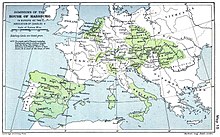
After Rudolf I was elected Roman-German king, the Habsburgs established an important household power with the acquisition of the duchies of Austria and Styria (by enfeoffing Rudolf's sons). With further territorial gains in the east and the loss of the old Habsburg possessions in Switzerland due to the Swiss Habsburg Wars in the 14th and 15th centuries, the center of power finally shifted to the Eastern Alps. The Habsburg itself fell to the Confederates in 1415. Nevertheless, the relations between the Habsburgs and their former heartland remained close. This was evident at the Muri Monastery and the Königsfelden Abbey , most recently in the decades-long stay of the last Empress, Zita , in Switzerland.
The fact that the elector did not take into account in the Golden Bull prompted Duke Rudolf IV. 1358/1359 to forge the Privilegium Maius , in which he claimed the title of Archduke , which later became characteristic of the Habsburgs. However, the Italian scholar Francesco Petrarca came to the conclusion that the documents had been forged. The Privilegium Maius was not granted until 1453 by the Habsburg Emperor Friedrich III. confirmed and recognized under imperial law.
The ore house of Habsburg demanded an almost sacred place for itself in society and in the structure of the empire, combined with the claim to the imperial crown. The expression of this mental attitude is that of Emperor Friedrich III. introduced motto AEIOU , the interpretation of which triggered a variety of speculations, but is probably to be understood as Austriae est imperare orbi universo (“Austria is destined to rule the world”). The Pietas Austriaca of the Erzhaus, which also loved to call itself the Casa d'Austria and thus affirmed its claim to power in Spain and Italy, is impressively expressed on the plague column, which was dedicated to the Trinity by Emperor Leopold I in 1679 and in Vienna was erected. On its three sides, representing the Trinity of God, the coats of arms and crowns of Austria, Bohemia and Hungary can be seen, with Austria tellingly not wearing the ducal hat but the imperial crown. Huge stone scrolls held by angels explain the Habsburg state program to the viewer: Austria with the imperial crown is assigned to the Deo Patri Creatori, Bohemia with the Wenceslas crown to the Deo Filio Redemptori and Hungary with the St. Stephen's crown to the Deo Spiritui Sanctificatori. The three main countries of the Habsburgs correspond to the heavenly trinity on earth - each independently, but united to an indissoluble unity, for the salvation of the world. The burial place of the Habsburgs in the Capuchin Crypt in Vienna underlines the sacred character of the ore house.
The Habsburgs as rulers of the Holy Roman Empire
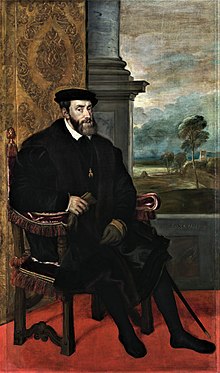
Since King Albrecht II was elected in 1438, the Habsburgs - with the exception of Emperor Charles VII (1742–1745) - had all emperors of the Holy Roman Empire until the end of 1806.
With the help of their marriages , the Habsburgs in the pouring 15th century by acquired Maximilian I , the Burgundian Netherlands , the Franche-Comte and then the crowns of Spain , Bohemia , Croatia and Hungary ( Habsburg monarchy ). With the Bohemian crown, the electoral dignity and thus the vote of the highest ranking secular member among the seven electors finally fell to the Habsburgs in 1526 (for the ranking see elector ).
With the successors of Emperor Charles V , the Habsburgs split into a Spanish and an Austrian line. After the extinction of the Spanish line with Charles II in 1700, the Austrian Habsburgs were only able to gain a small part of the Spanish heritage in the War of the Spanish Succession .
In 1740 the Austrian line also died out in the male line. Through the Pragmatic Sanction of 1713, Charles VI. in this case the inheritance rights of female descendants secured, whereby his daughter Maria Theresa took over the rulership rights. After her marriage to Franz Stephan von Lothringen , the dynasty called itself Habsburg-Lothringen . After the death of Emperor Franz I Stephan, it was the Emperor of the Holy Roman Empire of the German Nation from 1765 to 1806.
In 1806 Emperor Franz II laid down the crown as a result of the Napoleonic Wars; the Holy Roman Empire was thus de facto extinct.
Empire of Austria
Already before, in 1804, Emperor Franz II had proclaimed the hereditary empire of Austria as Franz I in order to maintain equality of rank with Napoleon , who had been proclaimed Emperor of the French in the same year. The Austrian Empire comprised all Habsburg hereditary lands. In 1867 it was converted to the Austro-Hungarian monarchy ; this disintegrated with the end of the First World War in 1918.
In the new Austrian Empire, the private crown of the House of Habsburg, made in Prague on behalf of Emperor Rudolf II. In 1602, was declared the official Austrian imperial crown , but a coronation as Emperor of Austria never took place. However, Franz I had himself painted wearing the crown. In contrast, all Austrian emperors - Franz I (1804–1835), Ferdinand I (V.) (1835–1848), Franz Joseph I (1848–1916) and Karl I (IV.) (1916–1918) accepted ) - to be crowned Hungarian kings with the St. Stephen's crown in order to comply with Hungarian constitutional law; Franz Joseph, of course, only in 1867, after almost twenty years of fighting with the Hungarian estates. The coronation with the Bohemian Wenceslas crown took place for the last time in 1836 for Ferdinand I (V.). He was also the only Austrian emperor to be crowned with the Iron Crown of Lombardy (1838) .
Habsburgs after 1918
On November 11, 1918, Emperor Karl I renounced any share in state affairs for German Austria , and on November 13 as King Charles IV of Hungary. Since Karl did not formally abdicate , - in contrast to the German Empire - any reference to the then 6-year-old Crown Prince Otto could be omitted. The other parts of the dual monarchy dissolved by Hungary on October 31, 1918 through the termination of the Realunion made themselves independent of the ruling house without contact with Charles. In March 1919 he and his family moved to Switzerland to avoid internment in Austria.
The Habsburg Law of German Austria of April 3, 1919, expelled Karl permanently from the country, all other members of the Habsburg-Lothringen family as long as they did not officially renounce their membership of the House of Habsburg-Lothringen (i.e. the dynasty with its claims to power) and claim to be loyal citizens of the republic had known. In addition, the Habsburg family funds were expropriated (but not demonstrably personal private assets ). The members of the house opted partly for republican Austria and partly for life outside the new republic. Until the Federal President's election in 2010 , according to the Federal Constitutional Act 1920 with Art. 60, Paragraph 3, 2nd sentence, most recently in the version of July 1, 2007, members of governing houses or families who had previously ruled were eligible for election as Federal President (“Passive right to vote”) in Austria. It was not until June 16, 2011 that the Habsburg Paragraph was repealed by the Austrian National Council as part of the 2011 Electoral Amendment Act and came into force in the new version ( Art. 60 B-VG) on October 1, 2011.
After two failed attempts at restoration by King Charles IV in Hungary in 1921, the Hungarian parliament decided on November 6, 1921 to dethrone the House of Habsburg-Lorraine. Hungary remained a kingdom without a king under the imperial administrator Miklós Horthy . After the second attempt at restoration, Karl was banished from Hungary to Madeira by the Allies, where he died in 1922 after a serious illness. His widow Zita was only allowed to return to Austria in 1982.
During the interwar period and the Second World War, the Habsburg-Lothringen family tried to treat Austria as a victim state and helped many persecuted people to flee. From 1930 to 2006 the head of the family was Otto Habsburg-Lothringen (1912–2011) as the eldest son of Emperor Karl. He did not sign the declaration of renunciation required by the Republic of Austria under the Habsburg Law until 1961. Under his aegis, the priority areas of employment of many members of the family (including Karl, Georg and Walburga) were shifted to European politics, especially that of the Pan-European Union , with theirs Founder, Richard Coudenhove-Kalergi , Otto Habsburg was friends.
The Black-Yellow Alliance has existed in Austria since 2004 , a party that campaigns for the restoration of the monarchy under the Habsburgs.
On January 1, 2007, Otto Habsburg-Lothringen transferred the role of head of the family to his eldest son Karl .
2011 was by Karl von Habsburg of the Order of St. George - A European Order of the House of Habsburg-Lothringen introduced as Order of the House of Habsburg (re).
The coat of arms of the Habsburgs

Coat of arms of the Habsburgs in Renaissance style from the roll of arms of Austria-Hungary by Hugo Gerhard Ströhl , Vienna 1890, panel II.
|

Family coat of arms of the Habsburgs, modern representation based on old coats of arms
|

Austria under the peacock bump. Scheibler's book of arms , older part
|
Development until 1804
The old coat of arms of the Counts of Habsburg showed a red, blue-armored and tongued, blue-crowned lion in gold. The lion is growing on the helmet with red and gold blankets , at the back with a notched red umbrella board, the tips of which are decorated with peacock feathers. The lion also appears uncrowned in old depictions , and the rear umbrella board of the helmet ornament is also silver, as can be seen in the Zurich coat of arms , but the umbrella board was (rarely) also shown in gold.
The lion coat of arms can still be found in numerous municipal and city coats of arms of the former Habsburg areas, especially in Upper Austria - such as Rheinfelden (Baden) , Bremgarten AG , Laufenburg AG , Laufenburg (Baden) , Bonndorf , Bräunlingen and Wislikofen ; the city of Waldshut received it in 1468 as a coat of arms. In Munderkingen it is shown together with a star, in Veringenstadt and Gammertingen together with the stag bar from Württemberg. While Sempach still shows the old coat of arms with the lion, Sursee has switched to a rotated, simplified tie shield coat of arms of the Dukes of Austria. The coat of arms of Kriessern shows a reclining lion which also the orb in the paws holds a reference to the former Reichshof Kriessern.
When the Habsburgs became dukes of Austria in 1282, they also adopted the red-white-red state coat of arms, the binding shield , which in the following years increasingly became the actual coat of arms of the dynasty. King Friedrich (III.) The Beautiful already placed the shield on the chest of the imperial eagle in 1325 . In contrast, the old coat of arms of the Counts of Habsburg faded more and more into the background.
The coat of arms of Emperor Rudolf II shows a simply split shield on the chest of the imperial eagle, the heraldic on the right (seen from the observer so left) the shield for Austria, heraldic on the left (from the observer on the right) shows the coat of arms of Castile . Maria Theresa only had a red-white-red heart shield in the center of her coat of arms, which no longer stood for a specific territory, but was to be understood in a dynastic sense. Her son Joseph II , with whom the rule of the House of Habsburg-Lothringen began, split his heart shield, which "now has to consist of the Austrian and Lorraine coat of arms"; his brother and successor Leopold II added that of Tuscany to these two fields , so that the heart shield now contained three fields.
The coat of arms since the proclamation of the Austrian Empire
The proclamation of the Austrian Empire in 1804 and the end of the Holy Roman Empire in 1806 led to a series of changes in the title and coat of arms of the Habsburgs. In 1804 it was declared that the “now coat of arms of the Most Sublime House of Austria” was a “silver crossbar in the red field”, hence the red-white-red shield.
1806 but the heart shield acquires its definitive shape: The shield (perpendicular) twice split and contains the heraldic right field the old Habsburg coat of arms (red, blue crowned lion on a golden background), the heraldic left field the coat of arms of Lorraine (three silver, mutilated eagles on a diagonal red bar on a golden background), in the middle the Austrian coat of arms (a silver crossbar on a red background). Together, this coat of arms is referred to as "the genealogical coat of arms of the most noble ruling imperial family".
The little coat of arms of Austria-Hungary from November 1915 to October 1918 was intended for use in the joint institutions of the Austro-Hungarian monarchy. It shows heraldic right (that is seen from the label support from) the Austrian double eagle, heraldic left the Hungarian coat of arms. The two coats of arms are surmounted by the coat of arms of the House of Habsburg-Lothringen: Heraldic right in gold a blue crowned red lion (Habsburg), in the red middle field a silver crossbar (Austria), heraldic left in gold a red sloping bar with three mutilated silver eagles (Lorraine) . It is crowned with a royal crown and decorated with the Order of the Golden Fleece (Toison d'or). The separation of the Habsburg house coat of arms and the double-headed eagle only took place in the course of the last coat of arms reform in 1915, to accommodate the Hungarians, for whom the double-headed eagle was a reminder that Austria had tried to integrate Hungary into a unitary state until 1866. The double-headed eagle is therefore only rooted with the Austrian Empire - by which Cisleithania is to be understood - and contrasted with the equal royal Hungarian coat of arms. Both coats of arms are connected by a smaller, towering coat of arms with the genealogical coat of arms of the Habsburgs. The war prevented the continuous introduction of the new symbol of the dual monarchy until its dissolution in 1918.
Lists of persons
genealogy
- Habsburg tribe list
- Family list of the House of Habsburg-Lothringen
- Habsburg-Laufenburg and Neu-Kyburg , side lines from the 13th to 15th centuries
Roman-German emperors and kings from the House of Habsburg
- Rudolf I , King 1273–1291
- Albrecht I , King 1298–1308
- Frederick the Beautiful , Anti-King 1314–1330
- Albrecht II , King 1438–1439
- Friedrich III. , King 1440–1486, Emperor 1452–1493
- Maximilian I , king 1486, emperor 1508–1519
- Charles V , King 1519, Emperor 1520–1556 (abdicated), † 1558
- Ferdinand I , king 1531, emperor 1558–1564
- Maximilian II , king 1562, emperor 1564–1576
- Rudolf II , King 1575, Emperor 1576–1612
- Matthias , King and Emperor 1612, † 1619
- Ferdinand II , King and Emperor 1619–1637
- Ferdinand III. , King 1636, Emperor 1637–1657
- Ferdinand IV , King 1653–1654
- Leopold I , King and Emperor 1658–1705
- Joseph I , King 1690, Emperor 1705–1711
- Charles VI , King and Emperor 1711–1740
Roman-German emperors and kings from the House of Habsburg-Lothringen
- ( Franz I. Stephan , King and Emperor 1745–1765 House of Lorraine)
- Joseph II , King 1764, Emperor 1765–1790
- Leopold II , King and Emperor 1790–1792
- Franz II , King and Emperor 1792–1806 (empire expired, crown laid down), † 1835
Emperor of Austria from the House of Habsburg-Lothringen
- Franz I , Emperor 1804–1835
- Ferdinand I , Emperor 1835–1848 (resigned government, retained title), † 1875
- Franz Joseph I , Emperor 1848–1916
- Karl I. Kaiser 1916–1918 (1918 renunciation of any share in state affairs , proclamation of the republic, exile without abdication), † 1922
Heads of families since 1918
- Karl until 1922
- Otto von Habsburg 1922–2006 (until the age of majority 1930 with mother Zita )
- Karl Habsburg-Lothringen since 2007
Emperor of Mexico from the House of Habsburg-Lothringen
- Maximilian I. 1864-1867
Kings of Spain and Portugal from the House of Habsburg (Casa de Austria)
See also Spain under the Habsburgs
- Philip I 1504–1506 ( King of Castile )
- Charles I 1516–1556
- Philip II (in Portugal : Philip I) 1556 / 1580–1598
- Philip III (in Portugal: Philip II.) 1598–1621
- Philip IV (in Portugal: Philip III) 1621–1640 / 1665
- Charles II 1665-1700
Kings of Bohemia and Hungary from the houses of Habsburg and Habsburg-Lothringen
- Rudolf I (only King of Bohemia ) 1306–1307
- Albrecht (as Roman-German king: Albrecht II.) 1438–1439
- Ladislaus V. Postumus 1440-1457
- Ferdinand I (Roman-German Emperor Ferdinand I) 1527–1564
- Maximilian (Roman-German Emperor Maximilian II.) 1564–1576
- Rudolf (Roman-German Emperor Rudolf II.) 1576–1608
- Matthias II (Roman-German Emperor Matthias) 1608–1619
- Ferdinand II. (Roman-German Emperor Ferdinand II.) 1619–1637
- Ferdinand III. (Roman-German Emperor Ferdinand III.) 1637–1657
- Ferdinand IV. (Roman-German king (= heir to the throne) Ferdinand IV.)
- Leopold I (Roman-German Emperor Leopold I) 1657–1705
- Joseph I (Roman-German Emperor Joseph I) 1705–1711
- Charles II (Bohemia) / III. (Hungary) (Roman-German Emperor Charles VI.) 1711–1740
- Maria Theresia (Rex Bohemiae, Rex Hungariae) 1740–1780
- Joseph II (Roman-German Emperor Joseph II) 1780–1790
- Leopold II (Roman-German Emperor Leopold II) 1790–1792
- Franz I (Emperor Franz I of Austria) 1792–1835
- Ferdinand V (Emperor Ferdinand I of Austria) 1835–1848
- Franz Joseph I (Emperor Franz Joseph I of Austria) 1848–1916
- Charles III (Bohemia) / IV. (Hungary) (Emperor Karl I of Austria) 1916–1918
Rulers of Austria from the houses of Habsburg and Habsburg-Lothringen
see:
- List of margraves and dukes of Austria in the Middle Ages 871–1457 / 1463
- List of the Archdukes of Austria 1457 / 1463–1918
- Lists of the Habsburg branch lines:
- List of the rulers of Inner Austria (Styria, Carinthia, Carniola and coastal regions) 1379 / 1411–1457 (Albertiner and Leopoldiner) and 1564–1619
- List of the rulers of Tyrol 1363–1490 and 1564–1665 (older and younger Tyrolean line)
Rulers and governors of the Burgundy state and the Netherlands from the houses of Habsburg and Habsburg-Lothringen
- Philip IV (King Philip I of Castile) 1482–1506
- Karl II. (Roman-German Emperor Karl V) 1506–1555 (Lieutenants including Margaret of Austria 1507–1530; Maria of Hungary 1531–1555)
- Philip V (King Philip II of Spain) 1555–1598 (governor and others Margarete von Parma 1559–1567; Juan de Austria 1576–1578; Ernst of Austria 1594–1595; Albrecht VII of Habsburg 1596–1598)
- Albrecht VII of Habsburg and Isabella of Spain , 1598–1621
- Philip VI (King Philip IV of Spain) 1621–1665 (governor and others Isabella of Spain 1621–1633; Ferdinand of Spain 1633–1641; Leopold Wilhelm of Austria 1647–1656; Juan José de Austria 1656–1659)
- Charles III (King Charles II of Spain) 1665–1700
- Karl IV. (Roman-German Emperor Karl VI.) 1700 / 14–1740 (governor among others Maria Elisabeth of Austria 1724–1741)
- Maria Theresia (Maria Theresia v. Austria) 1740–1780 (governor and others Maria Anna of Austria 1744)
- Joseph (Roman-German Emperor Joseph II.) 1780–1790 (governor and others Marie Christine of Austria 1781–1793)
- Leopold (Roman-German Emperor Leopold II) 1790–1792
- Franz (Roman-German Emperor Franz II.) 1793–1794 (governor and others Karl von Österreich-Teschen 1793–1794)
Grand Dukes of Tuscany from the House of Habsburg-Lothringen
- Franz Stephan v. Lorraine (Roman-German Emperor Franz I) 1737–1765
- Leopold I (Roman-German Emperor Leopold II) 1765–1790
- Ferdinand III. 1790–1800, again 1814–1824
- Leopold II. 1824–1849, again 1849–1859
- Ferdinand IV. 1859-1860 (annexed to the Kingdom of Sardinia)
Dukes of Modena from the House of Habsburg-Lothringen and Austria-Este
- Francis IV. 1814-1846
- Francis V 1846-1848, 1849-1859
Duchess of Parma from the House of Habsburg-Lothringen
- Marie-Louise 1814-1847
Imperial Administrator of the German Empire (1848–1849) from the House of Habsburg-Lothringen
- Johann 1848-1849
Further
- List of Roman-German rulers
- List of rulers of Croatia
- List of rulers of Hungary
- List of Moravian rulers
- List of Bohemian rulers
- List of heads of state of Spain
- List of rulers of Tuscany
- List of rulers of Parma
- List of Grand Masters of the Teutonic Order
- List of palatines of Hungary
See also
- Austrian imperial anthems
- Habsburg lip
- Asteroid (85199) Habsburg was named after the House of Habsburg
- Imperial Austrian family statute 1839
- The Habsburgs in Alsace
- Habsburg tombs
literature
sorted alphabetically by authors / editors
- Mathias Bernath , Karl Nehring, Felix von Schroeder (ed.): Biographical lexicon for the history of Southeast Europe. 4 vol., Munich 1974–1981 (last delivery 2014), ISBN 978-3-11-048982-8 ( online version at the Leibniz Institute for East and Southeast European Research , Regensburg )
- Henry Bogdan: Histoire des Habsbourg: des origines à nos jours . Perrin, Paris 2005, ISBN 2-262-02376-X
- August Burckhardt : Origin of the wife of Count Rudolf the Elder of Habsburg and relations between the Habsburgs and the Eptingians as well as the Schalern and Münch . In: Basler Zeitschrift für Geschichte und Altertumskunde , Vol. 15, 1916, pp. 371–399. ( Digitized version )
- Michael Erbe : The Habsburgs (1493–1918). A dynasty in the empire and in Europe. Kohlhammer, Stuttgart [a. a.] 2000 (Urban pocket books, vol. 454: Geschichte / Kulturgeschichte), ISBN 978-3-17-011866-9 ( "continues Karl Friedrich Krieger's Die Habsburg im Mittelalter " ).
- Géza Hajos: The House of Habsburg and Garden Art / The House of Habsburg and Garden Art = supplement to Die Gartenkunst 2008/2. Wernersche Verlagsgesellschaft , Worms 2008. ISBN 978-3-88462-271-1
- Heinz-Dieter Heimann : The Habsburg dynasty and empires. 3rd edition, Beck, Munich 2006 (Beck Wissen), ISBN 978-3-406-44754-9
- Lothar Höbelt : The Habsburgs. The rise and splendor of a European dynasty. Theiss, Stuttgart 2009, ISBN 978-3-8062-2196-1
- Pieter M. Judson: Habsburg. Story of an empire. CH Beck, Munich 2017, ISBN 978-3406706530 .
- Karl-Friedrich Krieger: The Habsburgs in the Middle Ages. From Rudolf I to Friedrich III. 2nd edition, Kohlhammer, Stuttgart 2004, ISBN 978-3-17-018228-8
- René Kollo : “A Kaiserschmarrn”. Germany and the Habsburgs . Lau-Verlag, Reinbek 2010. ISBN 978-3-941400-31-3
- Dorothy Gies McGuigan: Habsburg family 1273 to 1918. Splendor and misery of a ruling house. 10th edition, Berlin 2003, ISBN 3-548-33173-4 ( "short-lived family history" ).
- Bruno Meier : A royal family from Switzerland. The Habsburgs, Aargau and the Confederation in the Middle Ages. Baden / Switzerland 2008, ISBN 978-3-03919-069-0
- Dietmar Pieper , Johannes Saltzwedel: The world of the Habsburgs: splendor and tragedy of a European ruling house. Spiegel-Buchverlag / DVA, Hamburg 2010, ISBN 978-3-421-04476-1 .
- Karl Vocelka , Lyenne Heller: The Habsburgs' world. Culture and mentality history of a family. Graz / Vienna / Cologne 1997.
- Karl Vocelka, Lyenne Heller: The private world of the Habsburgs. Life and everyday life of a family. Graz / Vienna / Cologne 1998.
- Walter Pohl , Karl Vocelka: The Habsburgs. A European family history. Edited by Brigitte Vacha. Graz / Vienna / Cologne 1992, ISBN 3-222-12107-9 .
- Alan Sked : The Fall of the House of Habsburg. The untimely death of an empire. German translation by Stephen Tree, Siedler, Berlin 1993, ISBN 3-88680-409-7 .
- Adam Wandruszka : The House of Habsburg. The story of a European dynasty. 7th edition, Herder, Vienna [u. a.] 1989 (first 1956), ISBN 3-210-24569-X ( “still a standard work” ).
Biographical reference works
- Brigitte Hamann (ed.): The Habsburgs. A biographical lexicon . Vienna / Munich 1996 (3rd edition).
- Richard Reifenscheid: The Habsburgs in Life Pictures. From Rudolf I to Karl I Vienna 1990 (4th edition).
- Adam Wandruszka: Habsburg. In: New German Biography (NDB). Volume 7, Duncker & Humblot, Berlin 1966, ISBN 3-428-00188-5 , pp. 400-405 ( digitized version ).
Web links
- Literature by and about Habsburg in the catalog of the German National Library
- Works by and about Habsburg in the German Digital Library
- Franziska Hälg-Steffen, Peter Hersche: Habsburg, from. In: Historical Lexicon of Switzerland .
- The world of the Habsburgs Virtual exhibition on the history of the Habsburgs from 1278 to 1918
- Via Habsburg a cultural route of the Council of Europe
- Inbreeding shaped the face of the famous royal family
Individual evidence
- ^ "The House of Austria - the Habsburgs and the Empire" (en)
- ↑ a b c d e f g h Florian Neumann: Schnellkurs Mittelalter. ISBN 3-8321-7619-5 , Cologne 2006, pp. 139f.
- ^ Erwin Matsch: The Foreign Service of Austria (-Hungary) 1720-1920. Böhlau, Vienna 1986, p. 13.
- ^ Christian Lackner : The House of Austria and its countries in the late Middle Ages: Dynastic integration and regional identities. In: Werner Maleczek (Ed.): Questions of political integration in medieval Europe. Thorbecke, Ostfildern 2005, pp. 273–301, here: pp. 285–288 ( PDF ).
- ↑ Entry on Casa de Austria in the Austria Forum (in the AEIOU Austria Lexicon )
- ↑ DER SPIEGEL History , Hamburg, No. 6/2009, p. 32
- ^ National Council repairs postal voting. In: Der Standard , June 16, 2011. Retrieved July 19, 2011.
- ↑ Website " St. George's Order - A European Order of the House of Habsburg-Lothringen - History ", accessed on November 20, 2015
- ↑ On the subject of Anja Eisenbeiß: Arms and Images in Discourse. The example of the Habsburgs. In: Coat of arms as a symbol. Medieval heraldry from a communication and symbol theory perspective. (The Middle Ages. Perspectives of Medieval Research, Volume 11.2), Berlin 2006, pp. 98–120.
- ^ Carl Alexander von Volborth , Heraldik , 2nd edition Stuttgart 1992; P. 36
- ^ Announcement by the Imperial and Royal Prime Minister of November 3, 1915 regarding the coat of arms intended for use by the joint institutions of the Austro-Hungarian monarchy , RGBl. No. 328/1915 (= p. 793)
